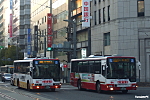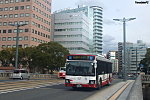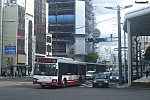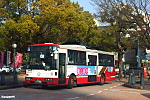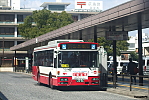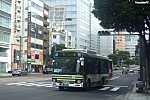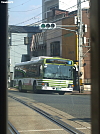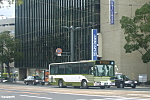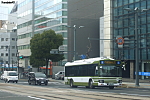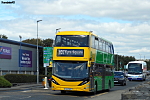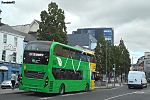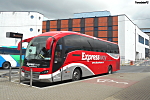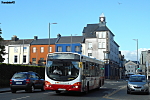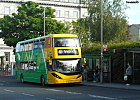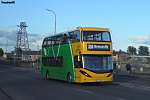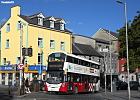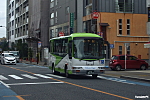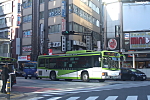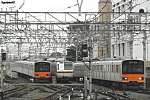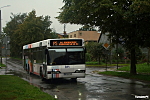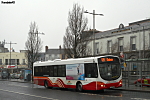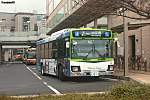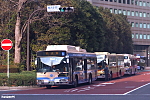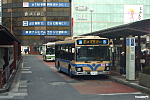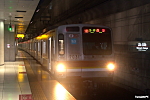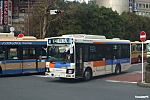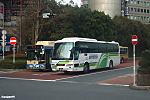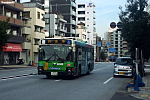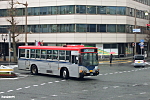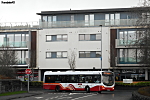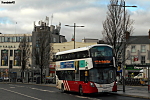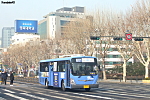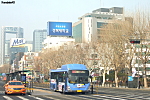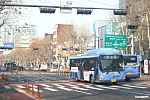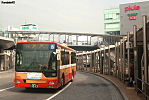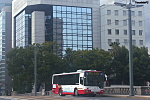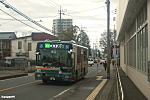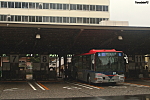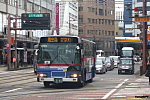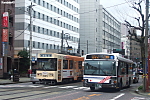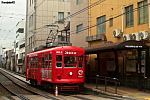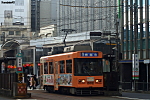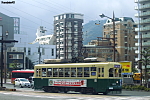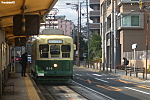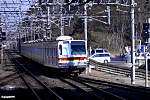Not logged in | Log in | Sign Up

Search Photos
Ikarus 260.04 #45151
23 july 2023 - Kraków, Kombinat, pętla o tej samej nazwie u zbiegu ul. Ujastek i al. Solidarności.538-02: Nowy Kleparz 11.30 → Kombinat 12.05
Poza standardową co niedzielę linią 0, Kraków w miarę regularnie uruchamia też inne połączenia specjalne obsługiwane zabytkami. 23 lipca miała miejsce czwarta takowegoż odsłona: linia 538 połączyła w trybie iście ekspresowym Nowy Kleparz z Kombinatem, obsługując po drodze tylko sześć przystanków pośrednich. Niewątpliwą atrakcją – podobnie do 25 czerwca i ówczesnej linii 579 – był przejazd przez zajezdnię Bieńczyce każdym kursem.
Niestety, linie specjalne na KLM mają jedną wadę: poprzez ułożenie w sposób łatwy do zapamiętania z pętli, rozkład jazdy utrudnia skakanie pomiędzy wozami. Trzeba albo mieć nadzieję, że uda się zgrać na jakimś nietypowym przystanku, albo stać na pętli ok. 50 minut. Winna była tego zarówno 579, jak i 538, ale nawet tramwajowe 15 i 23 nie są od tego problemu wolne, szczególnie 15 w odsłonie z 30 lipca, gdzie planowo na Pleszowie postój wynosił 48 minut.

Author: TranslatorPS 

Comments: 1
Solaris Urbino 18 CNG #1055
24 november 2021 - Radom, Ustronie, ul. Jana Pawła II.9-02: Os. Gołębiów I 11.02 → Os. Prędocinek 11.30
Przez pięć lat Radom kartonami obrósł. Czwartą generację flagowego produktu Solarisa wdrożyło pierw w liczbe 24 pojazdów standardowej długości o klasycznym napędzie konsorcjum firm Irex-4 i DLA w 2016 roku. W latach 2020 i 2021 operator miejski wzbogacił się o 19 pojazdów elektrycznych, również standardowej długości (dla przypomnienia, partie wynosiły odpowiednio 10 i 9 pojazdów, gdzie pierwszą zakupiło miasto poprzez MZDiK, a drugą już bezpośrednio MPK). Najnowszym zakupem jest niniejsza partia pięciu pojazdów przegubowych zasilanych CNG, której w momencie pisania tego opisu jest dopiero drugi miesiąc w ruchu. Daje to razem 48 pojazdów w tej stylistyce w Radomiu, co ciekawe we wszystkich używanych obecnie paliwach i źródłach napędu w tymże mieście. Czy liczba ta wzrośnie? Jest taka możliwość, wszak MPK ma zamiar zakupić razem 11 pojazdów wielkopojemnych w przyszłym roku (w tym 6 z napędem elektrycznym), ale nie mnie oceniać prawdopodobieństwo, że którekolwiek z nich będą z podpoznańskiej fabryki.

Author: TranslatorPS 

Solaris Urbino 12 electric #2004
24 november 2021 - Radom, Śródmieście, ul. Lekarska, przystanek Lekarska / Szpital.1-06: Os. Południe 11.45 → Os. Gołębiów I 12.21
Że wyświetlacze nie współpracują z aparatem to pewnie dla wielu z nas żadna nowość ;) W ramach anegdoty, jedynka na odcinku który mnie zawsze mentalnie myli, gdyż przystanki, z których ta linia odjeżdża w kierunku zarówno Południa jak i Gołębiowa I są przeciwne do tych, z których to robią linie 7 i 9 (ba, nawet przy pisaniu tego opisu pierw patrzyłem na pasujący odjazd z Gołębiowa zamiast z Południa). Niemniej jednak i w tej formie to połączenie się spełnia, a jego wagę w sieci miejskiej może potwierdzić m.in. wytypowanie do obsługi pojazdami elektrycznymi.

Author: TranslatorPS 

Mercedes-Benz Conecto G #1499
1 december 2021 - Łódź, Fabryczna, ul. Rewolucji 1905 r., skrzyżowanie z ul. Sterlinga.96A (96/14): Teofilów Rojna (10.43?) → Janów (12.02?)
Debiut wozu na galerii? No proszę...
Przedmieścia Łodzi były tego dnia nawet ośnieżone, ale w centrum miasta trudno było o białą połać na ulicach - prędzej na dachach, jak widać w tle. Potem zaczęło padać, ale nie lepiło się to w ogóle. Zdjęcie powstało w ramach jednodniowego wypadu niekomunikacyjnego z Radomia do Łodzi, do którego przetestowałem przy okazji połączenie przez Drzewicę (przy okazji też niechęć terminali konduktorskich ŁKA do biletów wystawianych przez Koleje Mazowieckie). Połączenie... powiedzmy, że rozsądne - szkoda tylko, że od dzisiaj odjęto mu od przyjemności drugą przesiadką w Koluszkach, przynajmniej w godzinach analogicznych do tych, co w dniu wykonania zdjęcia.

Author: TranslatorPS 

Mitsubishi Fuso PKG-MP35UM Aero Star #515
13 february 2019 - Hiroshima, Naka-ku, Hatchōbori (広島県広島市中区八丁堀).23-1: 横河駅 (Yokogawa-eki) → 大学病院 (Daigaku-byōin)
To the right, 536 on rte 24: 吉島営業所 (Yoshijima Eigyōsho) → 広島駅 (Hiroshima-eki)
Most of the routes operated by this company run every 12 minutes in the PM peak and every 15 in the interpeak (with AM peak services so often that a timetable isn`t really needed), although with individual routings being split off as variations some sections have poorer levels of service - for example on rte 23 every other trip is done as rte 23-1 as seen here, leaving behind a frequency of every 24 to 30 minutes on the unique sections. Terminus departures take place betweem 6am and 10pm, so as per the norm in Japan good luck with late evening services. Also as per the norm in Japan, and the same takes place on Hiroden`s network, the fare is paid when alighting at the front door, with a ticket to be taken when boarding by the middle door if paying by cash. I`m not exactly sure if this was brought in after my stay there, but there is a designated zone in Hiroshima city centre where all trips are 190 yen (€1.45) regardless of distance - outside of this zone, fares are calculated depending on the distance travelled, with adult singles ranging from 170 to 520 yen (€1.30 to €4) each.


Author: TranslatorPS 

Isuzu QDG-LV290N1 Erga Non-Step #240
14 february 2019 - Hiroshima, Inari-ōhashi (広島県広島市稲荷大橋).25: 広島駅 (Hiroshima-eki) → 井口車庫 (Inokuchi-shako)
If I am to believe Japanese Wikipedia, a portion of this company`s fleet is made up of used buses bought from the capital region. While the Erga in the photo is not one of those - having been bought brand new - it`s still curious as to why the Hiroshima-based company wasn`t seeking its fleet somewhere closer, for example in the Keihanshin area. On the other hand I`m under the impression that fleet replacement is going somewhat faster in the capital region, even if there isn`t really a push in Japan to operate low-floor only services.
Speaking of low-floor services, rte 25 is the only route of this company where departures scheduled to be operated by low-floor buses are marked. This is also particularly rare in Japan.


Author: TranslatorPS 

Isuzu QDG-LV290N1 Erga Non-Step #195
14 february 2019 - Hiroshima, Naka-ku, Ebisuchō (広島県広島市中区恵美須町).21-2: 広島駅 (Hiroshima-eki) → 広島港 (Hiroshima-minato)
To go along with the other photo, the typical version of rte 21 on its eastern half. The 八丁堀 Hatchōbori sheet doesn`t indicate a variation - all 21 trips go through this junction after all - but it`s more likely to serve to highlight that this route serves this major transfer point to begin with.


Author: TranslatorPS 

Nissan Diesel KC-UA460LSN / FHI 7E #391
13 february 2019 - Hiroshima, Nishi-ku, Yokogawachō 3-chōme (広島県広島市西区横川町3丁目), Yokogawa-eki bus terminus. The second company that I have something worth mentioning about when it comes to Hiroshima is this, Hiroshima Bus. Most of their network serves central Hiroshima, operating on routes numbered from 21 to 30 in a manner not conflicting with Hiroden`s network. They also share a number of circular routes near the business district and Hiroshima station with the tram operator. Their 224 city buses and 20 coaches are spread out between eight garages, operating a network of 212 km in length.

Author: TranslatorPS 

Place: 広島市 [Hiroshima-shi] (Hiroshima-ken)
| Owner: Hiroshima Bus 広島市 [Hiroshima-shi]
Nissan Diesel ADG-RA273KAN / NSK 96MC #627
13 february 2019 - Hiroshima, Minami-ku, Matsubarachō (広島県広島市南区松原町), Hiroshima-eki bus terminal.21-1: 広島駅 (Hiroshima-eki) → 広島港 (Hiroshima-minato)
Hiroshima station is an important point in this company`s network, as most of their routes meet here. Rte 21-1 seen in the photo is part of a really strange corridor, which in reality contains three separate routes: 21 which runs from neighbourhoods in eastern Hiroshima to the city centre, 21-2 which runs from Hiroshima station to Hiroshima port, and 21-1 as in the photo, which runs a route similar to 21-2, but along different streets (it`s pretty much a carbon copy of tram rte 1, aside from running two streets away towards the end of the route). Trips operating from one extreme end to the other only operate during rush hours, and not that many of them either - during most of the day this operates as realistically two routes with just four (!) stops in common. Of course on the common section this is all printed on one timetable page, which is of course loaded with variation markers - and while each half runs in the interpeak every 15 and is aligned to run every 7-8 minutes on the common section going westbound, they`re scheduled bumper to bumper going eastbound...


Author: TranslatorPS 

Hino SKG-KR290J2 Rainbow II #50544
14 february 2019 - Hiroshima, Naka-ku, Ebisuchō (広島県広島市中区恵美須町).4: 仁保車庫前 (Niho-shako-mae) → 県庁前 (Kenchō-mae)
This photo should make for a great example of the inconsistent marking of variations. There is a reason why I described the example of rte 4 as "good enough" under the last photo, and not completely good. The placard with "仁保南" (Niho-minami) seen on the driver`s console, alongside the top row of the LED scroll most likely, indicates a variation via the neighbourhood going by that name instead of taking a simplier route down the major roads. Travelling out of the city centre this variation is denoted as 4-2, as opposed to 4-1, but going inbound where there are only four stops in common before the route splits Hiroden isn`t messing around with a variation marker anymore. To make things even better, the route marked as a variation is done by about 60% of the departures from Niho garage.


Author: TranslatorPS 

Hino QKG-KV234N3 Blue Ribbon II #74834
14 february 2019 - Hiroshima, Naka-ku, Ebisuchō (広島県広島市中区恵美須町).2-2: 府中山田 (Fuchū-yamada) → 県庁前 (Kenchō-mae)
Hiroden uses a very peculiar route numbering system, which may be familiar to bus users in certain parts of the UK, or even better, Northern Ireland. Needless to say, bus and tram route numbers overlap, but that is no surprise to me. Most bus routes function as tree-like networks with a common route number - they depart from Hiroshima city centre along common routes that form the trunk of the tree, but sooner or later variations start splitting off like branches. To reduce the number of possible mistakes by passengers, individual variations are marked with an extra number after a hyphen. Therefore, on rte 2 seen in the photo it`s possible to see rtes 2, 2-1, 2-2, 2-5, 2-6, 2-7, 2-8, 2-9, and 2-12 on the scrolls. Where does the plain 2 with no suffix come in to this? More about this under the next photo.


Author: TranslatorPS 

Comments: 2
Isuzu QQG-LV234N3 Erga Hybrid #26766
13 february 2019 - Hiroshima, Minami-ku, Midori 1-chōme (広島県広島市南区緑1丁目).12-1: 東浄小学校前 (Tōjō-shōgakkō-mae) → 仁保沖町 (Niho-okimachi)
A slightly different shot - done very unexpectedly from on-board a rather older car on tram route 5. To wrap it up, some information about Hiroden`s bus network, but also the company itself. As of the end of March 2020, Hiroden operated a bus network of total route length of 1335.6 km using a fleet of 544 buses, carrying a daily average of 111 thousand passsengers. The entire company had 1780 employees at the time. Both of Hiroden`s transport branches are loss-incurring, as in fiscal 2019 Hiroden made a loss of 28 million yen on the tram network, equating nearly €216,000, and a loss of 1.075 billion yen on the bus network, or 8.29 million euro. Overall however the company is making profit (579 million yen in fiscal 2019, or 4.67 mln euro) due to its notably profitable housing development and renting business which easily makes up for the losses from its transport busieness - a model to be found not only at Hiroshima Dentetsu when it comes to Japan.


Author: TranslatorPS 

Hino KL-HU2PMEA Blue Ribbon #24639
14 february 2019 - Hiroshima, Minami-ku, Inarimachi (広島県広島市南区稲荷町).70-3: 広島駅前 (Hiroshima-eki-mae) → あさひが丘 (Asahigaoka)
It took me an eternity and a half, but I finally got around uploading a series of photos from Hiroshima. For starters, we`ll go with the bus section of the tram-and-railway company, which finds its beginnings as far as 1928. The company currently consists of eight divisions, which are responsible for a total of 31 depots - although many of them are simply outbases where buses are scheduled to visit the main garage during the day.
For a bit of introduction, I`ll explain the five-digit fleet numbering system. The first digit indicates the division allocation (although a few characters have special meanings, e.g. a three is a bus for hire regardless of division), the second digit indicates the manufacturer. The third digit indicates the suspension type (0-4 for leaf springs, 5-9 for pneumatic suspension), and the last two digits make up the individual bus - but never ending in 42. There are exceptions to this, but they won`t be part of this series. To make an example out of this bus, the 2 indicates allocation to Hiroshima-kita Eigyōka (Hiroshima North Division), the 4 indicates a standard-size Hino, and the 6 matches the pneumatic suspension.


Author: TranslatorPS 

Comments: 2
Hino 2SG-HL2ASBP Blue Ribbon Hybrid #64959
14 february 2019 - Hiroshima, Naka-ku, Hashimotochō (広島県広島市中区橋本町).3: 観音マリーナホップ (Kan`on Marina Hop) → 広島駅前 (Hiroshima-eki-mae)
I began a discussion about variation-marking suffixes as done by the bus section of Hiroden. What stood out was a plain rte 2 in the list of variations of that route. Where did it come from? The answer is simple enough, but perhaps irritating at the same time: Hiroden uses route numbers as simple as possible where common routings or common termini apply between variations. A good enough example of this is rte 4, where outbound departures are done as either 4-1, 4-2, or 4-3, but all inbound trips are operated scrolled as 4, despite different starting points. However, neither the "suffixes in one direction only" rule, nor the "each variation has a separate suffix" rule are applied universally (paradoxically there are as many inbound suffixes on rte 2 as outbound). Rte 3 in the photo is worthy of mention as there are no suffixes on this route, given that there are no route variations.


Author: TranslatorPS 

Alexander Dennis Enviro 400ER City 11m #PAD 89
18 june 2021 - Galway, Headford Road (R866).407, diagram 4070302: Bóthar an Chóiste 13.45 → Eyre Square 14.05
The hybrid just left bus stop 524101 Galway Centre - the name not referring in the least to the city centre, but to a shopping centre... not that stop naming has been a strong suit of the National Transport Authority, even if it`s somewhat better than the individual operators. The opposite-headed stop at this location, number 523721, is called Galway Retail Park.
One last photo to capture the nearside of these buses - amongst other things, the only externally located operator`s logo, or the plug-type second door, which is actually the standard for all dual-door double-deckers ordered in the last decade.


Author: TranslatorPS 

Place: Galway / Gaillimh (Galway / Gaillimh)
| Owner: Bus Éireann Dublin / Baile Átha Cliath | Transport Authority: Transport for Ireland | Route: 407
Alexander Dennis Enviro 400ER City 11m #PAD 76
11 june 2021 - Galway, Eyre Square North (R863).404: Westside Shopping Centre → Oranmore
To compliment the previous shots of hybrids, here is one from the back. The lack of a window on the lower floor is noticeable, and so is the lack of an offside emergency exit - however, the latter is not built into dual-door constructions to begin with. Another novelty is the wide rear scroll also showing the destination - the last buses in Ireland to have the destination shown on the rear were half-cab constructions from the 1960s. The Operator`s logo is located in only one spot on the outside - on the nearside between the doors - which is a controversial topic amongst many Irish fans, for whom the introduction of the new nationwide liveries is an attempt at hidden privatisation due to the reduction of Operators` identities... completely missing the point that at this stage it`s the network that is key and not the Operator.


Author: TranslatorPS 

Place: Galway / Gaillimh (Galway / Gaillimh)
| Owner: Bus Éireann Dublin / Baile Átha Cliath | Transport Authority: Transport for Ireland | Route: 404
Comments: 2
Volvo B11R 4x2 / Sunsundegui SC7-13M #VE 9
11 june 2021 - Galway, bus and rail station.Diagram 200101, layover between rte 20, Dublin Airport 7.00 - Galway 11.10 and rte X20 Galway 13.30 - Dublin Airport 17.05.
Not even a year and a half ago, Bus Éireann`s commercial operations, dubbed Expressway, were running widely and successfully. The subsequent pandemic however led to numerous cuts: it turned out to become the perfect excuse to cease running routes X1 (the inter-capital connection is now operated solely by the Northern Irish operator) and X12, and many other routes lost many departures. In 2018, route 20/X20 connecting Galway and Dublin saw 16 departures each way Monday to Friday and 14 on weekends - now we are down to 6 departures each way daily (three laps, including this one, operated by the Dublin garage, and the remaining three by Galway garage). Unfortunately I don`t have the information to compare the situation with that from before the pandemic effectively, however currently the capital`s depot deploys only 10 Expressway duties - I am however happy to bet that this is perhaps even only a third of what used to be deployed in 2019.


Author: TranslatorPS 

Comments: 1
Volvo B7RLE / Wright Eclipse Urban #VWL191
29 may 2021 - Galway, Eyre Square South (R336). Single deckers in Galway have fallen to the very bottom of the list of priorities - even on weekdays Bus Éireann is able to cover all 30 city diagrams with double-deckers. VWL191 as seen here has been degraded to a staff shuttle between the garage and the bus station, a distance of about 1.5 km by road. The shuttle is more useful for the city drivers - after all, drivers to have to cash in - than for the regional/intercity drivers, who primarily pull into the garage with the buses they arrived with.

Author: TranslatorPS 

Alexander Dennis Enviro 400ER City 11m #PAD 84
29 may 2021 - Galway, Eyre Square East, R336.409: Eyre Square - Parkmore Industrial Estate
Starting with the first half of April, hybrid double-deckers manufactured by Alexander Dennis purchased for use on PSO routes by the National Transport Authority have started to appear on Irish roads. As of writing this description, 280 units have been ordered out of a fraemwork contract for up to 600 vehicles. The first batch to have been ordered is for 100 buses, wherein the first 74 are for the capital`s Operator, Dublin Bus, to be split between four garages, and the remaining 26 for Bus Éireann`s Galway city routes. These buses feature the ability to travel approx. 2.5 km on the electric engine alone and are equipped with sockets for garage charging (they are so-called plug-in hybrids). In terms of appearance they stand out by their new livery, which is a mix of compromises between everybody (in particular those who should have no business in this), as well as white LED scrolls (aside from a test scroll on Dublin Bus` SG471, NTA has been ordering orange LEDs to date).


Author: TranslatorPS 

Place: Galway / Gaillimh (Galway / Gaillimh)
| Owner: Bus Éireann Dublin / Baile Átha Cliath | Transport Authority: Transport for Ireland | Route: 409
Alexander Dennis Enviro 400ER City 11m #PAD 80
29 may 2021 - Galway, Siobhán McKenna Road.404: Oranmore → Westside Shopping Centre
A short digression before the description proper: drivers still keep on setting up the Newcastle destination on the 404 despite the route terminating at Westside probably purely out of habit... which would be fine if it didn`t terminate at Westside S.C. for the past nine years, only serving Newcastle along the way.
The 74 units for Dublin Bus are numbered from PA1 to PA74 (the AVL numbers being 41001 to 41074), and the first route on which they appeared was the 140 operated by Broadstone garage (this route was transferred over from Harristown a few months prior, but even that garage will be receiving these hybrids, but for the 4). Dublin`s 140 is so far the only route on which they are meant to appear, however one bus has been sighted on the 66 already for example (most likely on one of the split duties which are numbered independent of route-based numbering). Bus Éireann`s fleet numbers follow on from Dublin Bus`, with a different prefix however - they are PAD75 to PAD100. These buses may and indeed do appear on everything in Galway - the target is to operate the entire city network in Galway with these hybrids - but so far only scarcely: today I only noted one each on the 404, 405, and 409, and a fourth one parked behind the railway station, and yesterday I was able to see one per each of 401, 402, and 404.
My thanks and regards to the driver!


Author: TranslatorPS 

Place: Dublin / Baile Átha Cliath (Dublin / Áth Cliath)
| Owner: Bus Éireann Dublin / Baile Átha Cliath | Transport Authority: Transport for Ireland | Route: 404
Volvo B5TL / Wright Eclipse Gemini 3 #VWD413
29 may 2021 - Galway, Eyre Square East, R336.407: Eyre Square → Bóthar an Chóiste
Along with the conversion of the entire state-sponsored city network in Galway to hybrid buses, it`s very likely that some widescale fleet movements will take place. One can assume that it`s nearly the end of the road for the 2008 single-deckers (since the contract stipulates a maximum fleet age of 14 years), and one of the smaller cities probably awaits the 2012 units. Double-deckers are far more interesting - Galway has a number of deckers made in 2018 and 2019, which will probably find their way to the other larger cities - Limerick and Cork. The catch is that the next city to be converted to hybrid buses after Galway is indeed Limerick, where the PVR is similar to Galway - it may turn out in the end that a whole lot of quite useful diesel buses from the last 5 to 7 years will find themselves without regular work.


Author: TranslatorPS 

Place: Dublin / Baile Átha Cliath (Dublin / Áth Cliath)
| Owner: Bus Éireann Dublin / Baile Átha Cliath | Transport Authority: Transport for Ireland | Route: 407
Comments: 2
Isuzu BDG-RX6JFBJ Journey J #754
12 september 2018 - Shiki (Saitama Pref.), Honchō 5-chōme (埼玉県志木市本町5丁目), Prefectural Route 244.志04 (shi-04): 柳瀬川駅 (Yanasegawa Station) → 志木駅東口 (Shiki Station East Exit)
Kokusai Kōgyō has a few of these middle-floor shorties for tighter routes. In order to confuse the enemy, they don`t show the route number anyway. This route here is an example of those tighter routes - it runs on streets where deploying a standard-sized bus would block the traffic for the rest of the day. Unfortunately the service level is just abysmal - the number of trips can be counted on Google Street View (12.5 laps Mon-Fri and 9 laps on weekends), and there are approx. three-hour gaps, probably to allow for driver breaks. Overall it connects two subsequent stations on the Tōbu Tōjō line which are only 100 seconds apart by train, but about 15-18 minutes apart on this bus. Overall it`s a curiosity that is probably in the red, but some social level of service must exist - even if it is commercial.


Author: TranslatorPS 

Isuzu PJ-LV234L1 Erga Non-Step #5132
7 january 2019 - Tōkyō, Toshima-ku, Nishi-ikebukuro 1-chōme (東京都豊島区西池袋1丁目), supposedly Metropolitan Route 441. The western side of Ikebukuro station is Kokusai Kōgyō`s lair, so to speak, as I had already shown before. The two buses displaying "out of service" are most likely only showing it to loop around the terminus located to the south of this intersection (behind the photographer). One of the buildings in the background houses a railway model shop, with prices easily able to make one doubt their wallet (but that`s railway modelling in general anyway).

Hino QPG-KV234L3 Blue Ribbon II Non-Step #5081
18 july 2019 - Niiza (Saitama Pref.), Tōhoku 2-chōme, bus terminus to the south of Shiki station (埼玉県新座市東北2丁目).志31 (shi-31): 新座団地 (Niiza-danchi) → 志木駅南口 (Shiki Station South Exit)
Route 志31 seen in the photo is operated together by Tōbu Bus and Seibu Bus, both companies deploying the service out of their respective Niiza garage. During most of the weekdays, the service operates every 10 to 12 minutes (with some gaps due to driver duty building), with the companies more or less alternating every other trip. The morning peak service sees departures 5 minutes apart, but even then the service requires only six buses. To make things more interesing, because every company sets up their own stop flag with their own information, it means that there are two versions of the route`s timetable at every stop, with each company carefully highlighting trips operated by the other as if it were a variation in routing.


Eidan 7000 #7110
4 july 2019 - Kawagoe (Saitama Pref.), western half of Tōbu Railway Kawagoeshi station (埼玉県川越市・東武川越市駅).Yūrakuchō/Fukutoshin/Tōyoko line diagram 93S.
Many thanks to this gentleman here. 7110F was taken out of service this week after 17101F began revenue service, the latter being the first set of the new Hitachi-manufactured 17000 series. Hitachi is taking care of the ten 10-car sets, while Kinki Sharyō is undertaking the construction of fifteen 8-car sets. Altogether the 180 cars are to replace the remaining 7000 series antiquities dating from 1974-89. Compared to the old trains, the new sets are to have more powerful air conditioning units, a lower floor level, and slightly wider seat spacing. At the same time the nominal capacity is increasing: for a 10-car set from 1424 to 1518 pax.
The company of two Tōbu 50000 series sets fits in quite well - the newly arriving 17000 series is being built on the same construction and structural concepts as the 50000 units seen here, even if they are 10 years apart.


Comments: 2
Solaris Urbino 12 CNG #1031
23 august 2018 - Radom, Młodzianów, ob. ul. Michalczewskiego.25: Potkanów / Stalowa → Os. Prędocinek
W momencie wykonania zdjęcia ten odcinek nie miał jeszcze nadanej żadnej nazwy ulicy, a przystanek, którego zatoki koniec widać po samej lewej, nosił wtedy jeszcze nazwę Młodzianowska / Jana Pawła II (choć od prawdziwej Młodzianowskiej przynajmniej 100 metrów). Nazewnictwo uregulowała dopiero Uchwała RM nr 153/2019 z dnia 15 kwietnia 2019 r., a więc prawie 8 miesięcy po wykonaniu zdjęcia, czy też 21 miesięcy po otwarciu tegoż odcinka.

Author: TranslatorPS 

Comments: 4
Neoplan N4020 #811
26 august 2018 - Radom, Dzierzków, ul. Odrodzenia.P5: Lotnisko / Odrodzenia → Os. Prędocinek
W przeciwieństwie do Autosanów, AirShow 2018 to był ostatni AirShow dla wielu Neoplanów, m.in. tego 811. Cechą charakterystyczną informacji pasażerskiej w okresie AirShow jest informowanie o obsługiwanych parkingach w kursach od lotniska.

Author: TranslatorPS 

Autosan M12LF #415
25 august 2018 - Radom, Prędocinek, ul. Armii Krajowej, pętla Os. Prędocinek.21: Os. Prędocinek → Lotnisko / Lubelska → Wólka Klwatecka
AirShow 2018 (nawiasem, 415 chyba się w tym tempie nie doczeka zdjęć z innego dnia) to był debiut Autosanów na imprezie masowej. Ciekawe było pojawienie się ich na 21 (chyba tylko w sobotę). Na zdjęciu też widać inne cechy tej imprezy - krótkie wozy na 9, czy o wiele więcej pojazdów na Prędocinku (w porównaniu z typową sobotą może i odpada duża część długich pojazdów, ale dochodzi P5 i sześć razy więcej 21ek).

Author: TranslatorPS 

Place: Radom (Mazowieckie)
| Owner: Michalczewski Radom | Transport Authority: MZDiK Radom | Route: 21
Neoplan N4020 #815
26 august 2018 - Radom, Dzierzków, al. Wojska Polskiego (jezdnia boczna). Zdjęcie nr 100.P3: Gołębiów / Holszańskiej → Lotnisko / Lubelska
Na setne zdjęcie Neoplan, który jeszcze po Radomiu się pałęta. W tle 942, przedstawiciel partii używanych MANów po warszawskim kontrakcie Michalczewskiego, które wraz z później zakupionymi jako fabrycznie nowe dalszymi MANami przyczyniły się do wyginięcia dużej części tych piętnastometrowych pojazdów.

Author: TranslatorPS 

Comments: 1
Solaris Urbino 18 CNG #1050
26 august 2018 - Radom, Sadków, al. Wojska Polskiego (jezdnia boczna).P1: Dworzec PKP → Lotnisko / Lubelska
Za starymi jezdniami al. Wojska Polskiego chyba nikt w Radomiu tęsknić nie będzie. Całą widoczną w tle infrastrukturę rozpruto i położono od nowa (według nowych planów) w okresie pomiędzy wykonaniem tego zdjęcia a końcem ubiegłego roku. I dobrze, bo 40-letni asfalt już dawno domagał się wymiany, serwując przejeżdżającym masaż wibrujący ;)

Author: TranslatorPS 

Volvo B7RLE / Wright Eclipse Urban #VWL185
10 january 2021 - Galway, Eyre Square North, R863.419: Oughterard → Galway
A very unexpected sighting. Rte 419 is a regional route which simply shouldn`t have city buses on it (road aside, the speeds are another story - city buses in Ireland are limited to 65 kph). I`m not exactly sure of the diagram of this bus, but it`s quite possible the same bus went out to Clifden soon afterwards - a trip three times as long as this from Oughterard (78.4 km vs 27.6 km).


Author: TranslatorPS 

Place: Galway / Gaillimh (Galway / Gaillimh)
| Owner: Bus Éireann Dublin / Baile Átha Cliath | Transport Authority: Transport for Ireland | Route: 419
Isuzu QPG-LV290N1 Erga Non-Step #3100
13 december 2018 - Shiki (Pref. Saitama), Honchō 5-chōme (埼玉県志木市本町5丁目), plac terminala autobusowego Shiki-eki Higashi-guchi.志05-3 (shi-05-3): 志木駅東口 (Shiki Station East Exit) → 中宗岡 (Naka-muneoka)
Pod zdjęciem 1064849 pada stwierdzenie, jakoby przewozy po japońskiej aglomeracji stołecznej to była głównie kwestia kolei. Sprostujmy więc lekko temat. Według statystyk podanych przez ministerstwo odpowiednie ds. transportu, w 2010 roku było 385 tys. użytkowników autobusowych biletów okresowych w aglomeracji stołecznej. Oczywiście przy dziennych 40 milionach pasażerów kolejowych oraz 8,5 milionach sprzedanych kolejowych biletów okresowych jest to naprawdę słaba liczba (ledwie niecały 1% użytkowników i prawie 4,5% posiadaczy), ale trzeba wziąć pod uwagę, że odsetek pasażerów korzystających z biletów okresowych w porównaniu do wszystkich jest zaskakująco niski (w 2010 r. w dojeździe do pracy 31% wszystkich pasażerów kontra 60% płacących z e-portmonetek). Kluczowy jest w tym fakt, że wiele dojeżdżających do pracy lub szkoły i jednocześnie korzystających z kolei dystans "ostatniej mili" pokonuje również innymi środkami, jak np. na rowerze (a ile mnie już takich prawie do szpitala zesłało!), czy też na piechotę. W porannym szczycie powszednim pomiędzy 70% a 95% korzystających z autobusów to dojeżdżający do pracy lub szkoły - liczba ta zmienia się zależnie od terminala autobusowego, natomiast ok. 60% wzwyż z tych osób korzysta z autobusów 5 dni w tygodniu, a ogólnie pasażerów regularnych (przynajmniej 2 dni w tygodniu) będzie pomiędzy 80% a 90%. Skalę autobusowych przewozów pasażerskich niech pokaże jednak jeszcze jedna kwestia, którą policzyłem już ja na podstawie informacji na stronach przewoźników. Wybrawszy z niemal setki przewoźników istniejących w aglomeracji tokijskiej kluczowe 18, tylko 14 z nich miało co prawda takową statystykę, ale te 14 firm razem wziętych posiadało na stanie, wliczając również pojazdy dalekobieżne - niespełna 11800 pojazdów. Obrazki więc jak ten wyżej - kilku ładujących pasażerów pojazdów, często wielu firm, są nie dość że uzasadnione, to bezsprzecznie częste... i potrzebne w funkcjonowaniu tego unikatowego organizmu. Brak angielskiego opisu celowy.

Author: TranslatorPS 

Comments: 6
Hino Blue Ribbon #4-3408
25 january 2019 - Yokohama (Kanagawa Pref.), Nishi-ku, Minami-saiwai 1-chōme (神奈川県横浜市西区南幸1丁目), Yokohama-eki Nishi-guchi bus terminal. Of course just because there is a municipal operator, it doesn`t mean that there are no other operators (well, more on that under further photos). Although two of the buses in the photo belong to the city, the middle one belongs to Kanachū, who operates seven routes from this terminus. Kanji-less numbering of three of them suggest routes operated together with the city, but as it turns out, only one of them (the express 62) is jointly operated by both municipal and private operators, with more departures by the latter - the other two, 1 and 5, are privately operated for nearly 13-14 yeras. Routes operated together by two different companies to this day remain a rather interesting mystery to me, given this is Japan which has no transport authorities at higher level (almost everything, no matter how you look at it, is commercial, albeit rather often profitable).

Author: TranslatorPS 

Place: 横浜市 [Yokohama-shi] (Kanagawa-ken)
| Owner: Kōtsū-kyoku 横浜市 [Yokohama-shi]
Comments: 2
Isuzu 2DG-LV290N2 Erga Non-Step #7-1826
25 january 2019 - Yokohama (Kanagawa Pref.), Nishi-ku, Minami-saiwai 1-chōme (神奈川県横浜市西区南幸1丁目), Yokohama-eki Nishi-guchi bus terminal.87: 横浜駅西口 (Yokohama Station West Exit) → 市民病院 (City Hospital) → 横浜駅西口 (Yokohama Station West Exit) (circular route)
Is this a normal route number? Yes! Yokohama City Bureau of Transportation does NOT use kanji characters in its route numbering. The number and scale of bus operations in Yokohama is slightly mind-numbing, but one way or another you got to somehow cover a 3.73 million population city, which aside from its metric ton of standard-length buses (!!) otherwise only relies on JR, Keikyū, Tōkyū, Sōtetsu, and its own two subway lines. A bit of interesting trivia about Yokohama: as an administrative unit, Yokohama-shi is the most populous city in Japan, however that`s not the case as a general urban unit, in which case it places second - if we can even consider the possibility of splitting out anyting in the wider Kantō agglomeration aside from arbitrary borders.


Author: TranslatorPS 

Comments: 2
Eidan 7000 #7031
25 january 2019 - Yokohama, Minatomirai Line Motomachi-chūkadai station.Yūrakuchō/Fukutoshin/Tōyoko Line diagram 13S: 713-142/B1413S/6xxx, Motomachi-chūkagai 14:06 → Hōya 15:41
There was a human-related incident on the Seibu Ikebukuro Line that day, and as a result through trains onto the subway and Tōkyū lines were slightly thrown off schedule. According to schedule, this train no. 713-142 should have departed from here at 14:06 - I took the photo at 14:12, while a certain stock allocation tracking website has a note stating "13S 31F 14:13 delayed departure from Motomachi-chūkagai" (I wasn`t the one to put it there), which to be honest isn`t all that bad for a post-accident mess - sometimes such an accident, or to be direct, most often a suicide results in the schedule gone out the window for the next 3-5 hours.


Comments: 4
Isuzu SKG-LR290J2 Erga Mio Non-Step #5759
25 january 2019 - Yokohama (Kanagawa Pref.), Nishi-ku, Minami-saiwai 1-chōme (神奈川県横浜市西区南幸1丁目), Yokohama-eki Nishi-guchi bus terminal.浜4 (hama-4): 保土ヶ谷駅東口 (Hodogaya Station East Exit) → 横浜駅西口 (Yokohama Station West Exit)
If anyone of you thinks that I`m going to run out of Japanese bus operators, they`re getting closer and closer to the mark. Sōtetsu Bus is closely related to the railway with the same name, which currently operates three lines, with the main terminal some 200 metres behind me. The bus operations area is closely related with the railway service area. The most curious thing of all is however the route number - although the kanji+number scheme is nothing new in the Tōkyō agglomeration, what is new is the kanji character being selected not from, for example, the nearest railway station, but... the operating garage! As a side effect there is a plethora of 旭 (asahi) routes without a single railway station in the area using this character (two of these terminate here anyway).


Author: TranslatorPS 

Comments: 4
Mitsubishi Fuso KL-MS86MP Aero Bus #6566
25 january 2019 - Yokohama (Kanagawa Pref.), Nishi-ku, Minami-saiwai 1-chōme (神奈川県横浜市西区南幸1丁目), Yokohama-eki Nishi-guchi bus terminal. Today`s lot of photos comes from this terminal. Sōtetsu has some intercity bus connections from Yokohama station towards Mount Fuji - judging from the current timetable, this bus arrived from there. In terms of other coach connections, just as any bus operator in the Tōkyō area should have, there is a Haneda airport route (only from Futamatagawa and shared with Keikyū, but still; the Ebina route is currently suspended).

Author: TranslatorPS 

Place: 横浜市 [Yokohama-shi] (Kanagawa-ken)
| Owner: Sōtetsu Bus 横浜市 [Yokohama-shi]
Hino PJ-KV234L1 Blue Ribbon II Non-Step #P-N323
25 december 2018 - Tōkyō, Bunkyō-ku, Ōtsuka 3-chōme (東京都文京区大塚3丁目), Metropolitan Route 437. Here`s a Christmas Blue Ribbon two years later. 25 December 2018 was a Tuesday, so Japanese transport companies operated a regular Monday-Friday schedule. Nevertheless not even a Saturday or Sunday schedule (for which there is no reason on December 25th unless it just falls on the appropriate weekday) would stop routes 学01 and 学07 (gaku-01 and gaku-07) from operating. They are two circular routes connecting the prestigious University of Tōkyō campus with nearby railway stations. I`m only mentioning these routes mostly because apart from 都02 (to-02) they are the only other options that this bus could be pulling out onto.

Isuzu U-LV324K Cubic #G1426-I
27 december 2018 - Niigata (Niigata Pref.), Chūō-ku, Higashi-ōdōri 1-chōme, Prefectural Route 33.E46: 万代シティ (Bandai City) → 新潟駅前 (Niigata Station) → 新発田営業所 (Shibata Depot)
I also have, why not, this back then 23-year-old Cubic as a present. I think I might have mentioned this with the original Niigata series, but the operator over there has a habit of pushing older stock into its subsidiary, which is responsible for the typically suburban and regional routes. Given that the network is quite centralised around Niigata station, Bandai City bus terminal and the city hall, it doesn`t change much in terms of variety in the city centre itself, however there is a noticeable difference in the middle of nowhere, where low-floor buses don`t venture a whole lot (not that Niigata Kōtsū marks low-floor departures on timetables to begin with). Vertical traffic light as a bonus.


Author: TranslatorPS 

Place: 新潟市 [Niigata-shi] (Niigata-ken)
| Owner: Niigata Kōtsū Kankō Bus 新潟市 [Niigata-shi] | Route: E46
Comments: 2
Volvo B7RLE / Wright Eclipse Urban #VWL169
4 december 2020 - Galway, Kingston Road and Shangort Road junction.402: Merlin Park Hospital → Seacrest
The 12-year-old single-decker is only one stop away from its terminus. Bus Éireann Galway deploys at least 27 buses Monday to Friday, but the number may be higher. With 24 double-deckers in the garage single-deckers are still needed. This should change early next year, however, as new double-decker hybrids will be brought into service. These hybrids have been purchased as part of a framework contract for the supply of up to 600 buses for Public Service Obligation contract routes.


Author: TranslatorPS 

Place: Galway / Gaillimh (Galway / Gaillimh)
| Owner: Bus Éireann Dublin / Baile Átha Cliath | Transport Authority: Transport for Ireland | Route: 402
Comments: 2
Volvo B5TL / Wright Eclipse Gemini 3 #VWD410
6 december 2020 - Galway, Eyre Square North, R863.405: Rahoon → Ballybane Ind. Estate
Should a network expansion occur (which is something not being mentioned by media when it comes to Galway), VWD410 seen here should not be endangered by the hybrid buses... Endangered meaning not removal from service (it`s only a 2-year-old bus after all), but transfer to another garage.


Author: TranslatorPS 

Place: Galway / Gaillimh (Galway / Gaillimh)
| Owner: Bus Éireann Dublin / Baile Átha Cliath | Transport Authority: Transport for Ireland | Route: 405
Hyundai New Super Aero City #서울74사9516
1 march 2019 - Seoul, Jongno-gu, Jong-ro (서울특별시 종노구 종로), Jongno 4-ga, Jongmyo bus stop.601: 개화역광역환승센터 (Gaehwa Station Transit Center) → 혜화역.서울연극센터(장면총리가옥) (Hyehwa Station, Seoul Theatre Centre (Sangmyeon Prime Minister`s House)) → 개화역광역환승센터 (Gaehwa Station Transit Center) (circular route)
What did I notice in South Korea? The South Korean capital doesn`t have one of the problems that the Japanese ones - the first one has noticeably more space. As such, the city has many wide roads with bus lanes along the middle like a tram. Bus traffic jams made up of mostly domestic buses are not a rarity in the most critical moments.


Author: TranslatorPS 

Place: Seoul (Seoul)
| Owner: Damoa Seoul | Transport Authority: Seoul Metropolitan Government | Route: 601
Comments: 2
Hyundai Aero City #서울71사1816
1 march 2019 - Seoul, Jongno-gu, Jong-ro (서울특별시 종노구 종로), Jongno 4-ga, Jongmyo bus stop.140: 도봉산역광역환승센터 (Dobongsam Station Transit Centre) → 양재2동주민센터.양재꽃시장 (Yangjae 2-dong) → 도봉산역광역환승센터 (Dobongsam Station Transit Centre) (circular rotue)
What does road transport look like in the Korean capital? Standard-length buses are trotting along happily without a public timetable (only first and last departures and frequencies are advertised) along routes that may appear to be bidirectional, but more often than not only have only one terminus with a proper layover, which is often enough near some garage. Only the airport buses appear to have a proper timetable. The only thing that otherwise helps in keeping a frequency level is the AVL panel in the driver`s cab, which shows the time distance from the bus ahead and behind.


Author: TranslatorPS 

Place: Seoul (Seoul)
| Owner: Korea brt Seoul | Transport Authority: Seoul Metropolitan Government | Route: 140
Comments: 3
Hyundai Aero City #서울74사3848
1 march 2019 - Seoul, Jongno-gu, Jong-ro (서울특별시 종노구 종로), Jongno 6-ga, Dongdaemun-jonghabsijang bus stop.720: 진관공영차고지 (Jinguan Public Garage) → 촬영소사거리.동답초등학교 (Chalyoungso Sageori, Dongdap Elementary School) → 진관공영차고지 (Jinguan Public Garage) (circular route)
Buses are permamently assigned to each bus route. Although a number of them has electronic displays, they always display the same content. They are plastered with route markings and route maps permamently both outside and inside. For example, for rte 720 seen in the photo 32 buses are authorised, and for the 140 seen on another photo - 46 buses. Overall, the 7400 buses operating the Seoul bus network are split between 65 individual companies, out of which each one takes care of between 3 and 14 routes, with fleet size between 40 and 293 buses per company. Although each company may have its own garages, there are also 11 public garages where multiple companies are based together.


Author: TranslatorPS 

Place: Seoul (Seoul)
| Owner: Jeil Seoul | Transport Authority: Seoul Metropolitan Government | Route: 720
Comments: 2
Mitsubishi Fuso Aero Star #6286
15 february 2019 - Himeji (Hyōgo Pref.), Ekimaechō (兵庫県姫路市駅前町), bus terminal area outside Himeji station.39: 姫路駅北口 (Himeji Station North Exit) → 龍野 (Tatsuno)
Today`s very random series is not motivated by location, but by bus type. Mitsubishi Fusō Aero Star is after all a rather rare model amongst Japanese city bus operators in recent years - given that the market is dominated by Isuzu Erga slash Hino Blue Ribbon (they`re the same thing...). Meanwhile this manufacturer will appear in Tōkyō (or rather in the state operations) for the first time in eight years, given its winning of a tender for supply of 140 buses. Other operators around Tōkyō don`t have the model seen in the photo in large quanities either (Tōbu doesn`t seem to have anything, the other major operators in rather small numbers), so this series is primarily from outside of the capital.


Author: TranslatorPS 

Mitsubishi Fuso Aero Star #547
14 february 2019 - Hiroshima (Hiroshima Pref.), Inari-ōhashi (広島県広島市稲荷大橋).25: 井口車庫 (Inokuchi Depot) → 広島駅 (Hiroshima Station)
Headlight frames painted like in a Lion`s City - the topic of the livery is one of many floating around now that the Tōkyō metropolitan government has announced the winner of the tender to supply 140 diesel-powered buses to be Mitsubishi Fusō. The titular company first offered its buses for 2,506,000,000 yen, so around 19.9 mln euro, or 142,350 euro per unit. Somehow however, through some sort of sorcery, their winning price was 2,756,600,000 yen, coming to around 156,600 euro per bus.
There will still be plenty of opportunities to discuss the bus side of Hiroshima.


Author: TranslatorPS 

Mitsubishi Fuso Aero Star #A5-829
13 december 2018 - Niiza (Saitama Pref.), Higashi 3-chōme (埼玉県新座市東3丁目), Prefectural Route 40.清61 (kiyo-61): 志木駅南口 (Shiki Station South Exit) → 清瀬駅北口 (Kiyose Station North Exit)
The yellow tactile tiles seen in the sidewalk leads to more or less where the bus should stop at the barely visible Rikkyō-mae stop. The route in the photo, 清61 (kiyo-61), is one of the numerous bus connections criss-crossing the primarily east-west railway network and connecting the various train stations. These routes however primarily serve as feeders to the nearest station as opposed to connecting the railway lines.


Author: TranslatorPS 

Mitsubishi Fuso Aero Star #H1026-M
30 december 2018 - Niigata (Niigata Pref.), Chūō-ku, Hanazono 1-chōme (新潟県新潟市中央区花園1丁目), Niigata-eki-mae bus terminal stands.E22: 新潟駅前 (Niigata Station) → 新潟空港 (Niigata Airport)
Stand no. 9, occupied by the Mitsubishi Fusō, is dedicated entirely to E2x routes. The airport bus, E22, is the shortest route alongside E21 out of all twelve routes on this corridor. Aside from rte E22 and its rather uninspiring schedule (every 30-70 minutes Mon-Fri and every 50-60 Sat&Sun) and a price tag of 420 yen, there is also an "airport limousine" for the same price, but non-stop and much more frequently (every 20-40 minutes every day with some gaps). Personally I didn`t have to use it - I arrived in Niigata on the Shinkansen - but it`s interesting to see the airport connections compared to some European cities, especially those smaller than Niigata. In terms of impressive frequency one has to see the entire E2x corridor, where E22 amounts to barely anything.


Author: TranslatorPS 

Comments: 2
Mitsubishi Fuso Aero Star #H1208-M
30 december 2018 - Niigata (Niigata Pref.), Chūō-ku, Nishiboridōri 5-banchō (新潟県新潟市中央区西堀通5番町), National Route 116.W10: 新潟駅前 (Niigata Station) → 内野営業所 (Uchino Depot)
The W1x corridor operates every 15 minutes Mon-Fri and every 20 minutes Sat&Sun for most of the day (with higher frequencies in the peaks of course). However, there is a clear lack of pattern as to which route will operate - during daytime there is more W11 trips, but during the peaks there`s more W10s. I can still respect them sticking to a frequency on the corridor though.


Author: TranslatorPS 

Isuzu PJ-LV234N1 Erga Non-Step #2604
11 february 2019 - Nagasaki (Nagasaki Pref.), Dōzamachi (長崎県長崎市銅座町). Putting aside how much I had to look for this place on Google Maps, this company has a really strange approach to passenger information. The number seen on the destination display doesn`t indicate the route as much as the destination area, or sometimes the route taken. Thus when using the stop timetables (which I already mentioned briefly under photo 1010960) one has to search for their route by the terminus name and then by the via points. The 20 seen in the photo is first the Ebira Line (江平線) towards the city centre, and second a very summary-like description of anything terminating at the Nagasaki Shinchi Terminal, or Chūō-bashi (Central Bridge). Well, the result is that timetables near the city centre look more like this...

Author: TranslatorPS 

Comments: 2
Isuzu PJ-LV234N1 Erga Non-Step #2715
11 february 2019 - Nagasaki (Pref. Nagasaki), Shinchimachi (長崎県長崎市新地町). A little complaining from me, but not unjustified complaining. However the route numbers of Nagasaki trams may make sense (daytime 1, 3, 4, 5, one lap as a 2, and unnumbered extra trips), I have no doubt that buses are simply asking to be reorganized, or rather have a normal system introduced. However, what am I expecting from a company that has a grid of green lines with bus stops marked for a network map, with no information on actual routes?

Author: TranslatorPS 

Isuzu KC-LV380N Cubic / NSK 96MC B-II #1826
11 february 2019 - Nagasaki (Pref. Nagasaki), Dejimamachi (長崎県長崎市出島町). Again a 1, but a different route (Ishihara/Kashiyama/Sakura-no-sato Line) and a different garage (Sakura-no-sato). If someone were to come from Kyōto (never mind Europe) where route numbers are holy, they`d likely get lost, because they`ll board a different 1 than they should, especially if five of them came at the same time, each one going in a different direction. Were I the company, I would seriously reconsider the purpose of this system.

Author: TranslatorPS 

Hino Blue Ribbon #3804
11 february 2019 - Nagasaki (Nagasaki Pref.), Dejimamachi (長崎県長崎市出島町). This 21-years-old (at the time) Cubic with NSK bodywork is commencing its approx. 50-minute long trip. The Nagasaki-shinchi - Megumi-no-oka (Nagasaki Junshin University) Line is another good example of messing around with numbers. Trips towards the city are scrolled as a 20, but outbound departures are either a 1 or a 9 depending on the via points. Not like it`s the only route using a 1 scroll - practically all routes operated by Matsugae depot carry the pair of 1 and 20, with some additional usage of 6 or 9 sprinkled in.

Author: TranslatorPS 

Isuzu Erga #2902
11 february 2019 - Nagasaki (Nagasaki Pref.), Dejimamachi (長崎県長崎市出島町). A 100 scroll set like this could honestly be any route operated by Yanagai depot (the bus belongs to it is what I`m implying here). To the left is 1503 with the tram depot on a white scroll, indicating one of the extra workings done along route 1 between Urakawa-shako and Shinchi-chūkagai. No idea where everything goes, but the locals seem to know what`s happening.

Author: TranslatorPS 

Nippon Sharyō Nagasaki Denki Kidō 360 series #364
11 february 2019 - Nagasaki, Matsuyamamachi (長崎県長崎市松山町), Heiwa-kōen (Peace Park) tram stop. A red tram heading towards Nagasaki city centre on the red route. 125 metres to the east from this car is the epicentre point of the explosion of the second atomic bomb to have been dropped on Japan. The miserable cloudy weather stayed strong throughout the first half of my trip to Nagasaki, including my visit to the museum dedicated to the attack. Only once I`d left the museum did the clouds part - a question follows, should I look for any signs in such a meteorological turn of events?

Author: TranslatorPS 

Comments: 4
Alna Sharyo Nagasaki Denki Kidō 1500 series #1502
11 february 2019 - Nagasaki (Nagasaki Pref.), Aburayamachi (長崎県長崎市油屋町), Shiambashi tram stop. This 26-year-old (at the time of the photo) Alna Sharyō car is only one stop away from its terminus. Along Harusame and Shiambashi Streets (legally speaking, along the final section of the Main Line, 本線 honsen) the tracks are laid down the middle of the road, and the stops are made of (really) narrow island platforms long enough for just one car at a time.

Author: TranslatorPS 

Comments: 6
Hitachi Nagasaki Denki Kidō 201 series #209
11 february 2019 - Nagasaki (Nagasaki Pref.), Hamaguchimachi (長崎県長崎市浜口町), National Route 206. This photo shows the air-conditioning units added in 1987 rather well. Japanese Wikipedia claims that some big changes were made to the external appearance of these cars when strengthening the body for air-con installation, but I struggle to see any when comparing with a 1954 photo, aside from perhaps changes to the side scroll location and the front window shape. The red bus in the background belongs to Nagasaki Ken`ei Kōtsū, a company that I somehow don`t have a single shot of...

Author: TranslatorPS 

Hitachi Nagasaki Denki Kidō 201 series #203
11 february 2019 - Nagasaki (Nagasaki Pref.), Ōbashimachi (長崎県長崎市大橋町), Urakami-shako (Urakami Depot) tram stop. All of the three-light signals seen in this photo (they always only show two lights) are shunting signals. Shunting signals of the exactly same style are used by practically all heavy railways in Japan, so it`s somewhat interesting to see them used in a tramway network as well. Signal 4 (under the red X) allows switching back on the mainline, as the track layout at the depot is quite inconvenient - in order to leave most of the depot tracks towards the city (as in head in the direction of this car), one has to pull out to the outbound platform and reverse on the mainline towards the city using one of the crossovers behind the tram in the photo. The other signals are used for pulling into one of the stabling tracks in the depot. Signal 8 seen above the platform to the right is also for entering the depot, however this is for cars on the inbound track which reverse using the platform where I`m standing. Quite a lot of shunting involved. The red X above signal 4 is to confirm point locking, as far as I remember.

Author: TranslatorPS 

Hitachi Nagasaki Denki Kidō 211 series #214
11 february 2020 - Nagasaki (Nagasaki Pref.), Nakazonomachi (長崎県長崎市中園町), National Route 206, Akasako tram terminus. A brief reprieve from the Kantō area in the form of nearly the edge of the country - Nagasaki. To start this short series off, a rather peculiar terminus structure: a single bi-directional platform (which by the way is the longest in the network, at 53 metres), split into three sectors. As such, three different cars can terminate here simultaneously. However for the same reason cars depart from here in reverse order of their arrival - first to arrive, last to leave. The points splitting off to the double-track section are right at the end of the platform (behind the photographer). Akasako is also the western-most tram stop in Japan.

Eidan 7000 #7002
4 april 2019 - Namegawa (Saitama Pref.), Haneo, eastern half of Tōbu Railway`s Shinrinkōen station (埼玉県比企郡滑川町羽尾・東武鉄道森林公園駅).Yūrakuchō/Fukutoshin/Tōyoko line diagram 87S: 787-132/B1387S/F1187S, Motomachi-chūkagai 13:03 → Shinrinkōen 14:53 (88.6 km)
For its first nine years, this set operated with only five cars (7102-7702-7802-7902-7002). Only by 1983 were the remaining five cars coupled in, hence half of the set is older than the other half... albeit equipped the same way.






